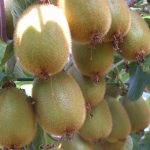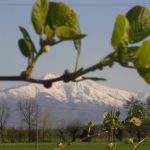
Name
Actinidia of Cuneo
Seal of quality
Prodotto Agroalimentare Tradizionale (PAT) / Typical food-farming product.
Description
The characteristic of this long-shaped fruit is its very hairy brownish skin. The colour of the inner part is a beautiful bright green and presents numerous seminal cavities inside which there are small black seeds (1000-1500 per fruit).
From a botanical point of view, it belongs to the Actinidia deliciosa species originally from China, where it grows spontaneously like creepers in the woods. As far as variety is concerned, the Hayword is the cultivated variety of reference selected in New Zealand in the 20s by a nurseryman of Auckland (Hayward Wright), which represents almost the entire production.
Cultivation does not require any particular phytosanitary care, since it does not result to be very sensitive to the attack of pathogens and, therefore, is easily managed in accordance with organic farming.
Nutritional-health characteristics: the kiwi is an average-calorie fruit, (44 kcal per 100g), it is thirst quenching, refreshing, diuretic and depurative. It is a good source of fibres (16%), of potassium (14%), vitamin E (10%), and contains a great quantity of vitamin C, which favours the body’s natural defences, strengthening the defence mechanisms against viruses and bacteria or chemical agents. The quantity of vitamin C exceeds that of oranges and, one kiwi alone is sufficient to reach the recommended daily dose of this vitamin. Furthermore, if eaten regularly, it improves bowel movement.
Nutritional characteristics
Follows the nutritional characteristics of Actinidia of Cuneo.
| FOOD | unit of measurement | Kiwi |
|---|---|---|
| Edible part | % | 87 |
| Water | g | 84.6 |
| Protein | g | 1.2 |
| Fat | g | 0.6 |
| Carbohydrates | g | 9 |
| Starch | g | tr |
| Soluble sugar | g | 9 |
| Total fibre | g | 2.2 |
| Energy | kcal | 44 |
| Kilojoules | kJ | 184 |
| Sodium | mg | 5 |
| Potassium | mg | 400 |
| Iron | mg | 0.5 |
| Calcium | mg | 25 |
| Phosphor | mg | 70 |
| Thiamine | mg | 0.02 |
| Riboflavin | mg | 0.05 |
| Niacin | mg | 0.4 |
| Vit A ret. eq. | mcg | |
| Vit C | mg | 85 |
| Vit E | mg |
Area of production
Piedmontese and Tableland regions of the province of Cuneo.
History
The first studies carried out on this plant date back to the beginning of the 20th century, when samples belonging to the Actinidia species were introduced in New Zealand , and where they were first studied and the first variety selections were carried out. Even the same “Hayword” variety, which still stands out unchallenged on the market, was selected in that country in the 20s by a nurseryman of Auckland (Hayward Wright).
Sometime in the 40s, the first plants were set up and following an initial period of cultivation, really a pioneering period, the production skyrocketed, and enabled this country to enter the world market unrivalled, accomplishing, in this initial phase, a genuine fortune. Its cultivation became so important in New Zealand and aroused such enthusiasm that it was renamed “kiwi”, in honour of the bird of the same name, which is the symbol of New Zealand . Now, the word kiwi is recognised universally indicating the fruits of this plant.
The species was first introduced in Italy in 1971-72, when certain samples were introduced even in Cuneo. Here, this fruit has found fertile land on which to grow, having a good availability of irrigation water and of fruit farmers capable of developing new techniques which have been exported to the rest of the world. The 80s experienced a constant increase of cultivated land, and which every two years doubles, going from 2,000 acres in 1982 to 15,926 in 1988, reaching 23,400 acres in 2004. Having beaten New Zealand , Italy is now leader on a worldwide scale, and Cuneo is the second province in terms of production in Italy , with 3,800 hectares and a production of approx. 835,000 quintals.
Galleria fotografica



